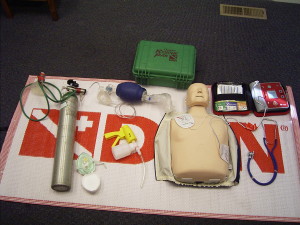The title might seem a bit daunting, Diving Emergency Management Provider. What does it really mean? It means you’re trained to provide basic life support and first aid for diving related injuries. Still sounds intense, right? Remember, in a nutshell basic life support comes down to making sure the person’s heart is beating or you pump the blood yourself with chest compressions, CPR. First Aid often comes down to applying direct pressure to stop the bleeding. For diving related injuries, we have some more specifics, but otherwise it’s basically that simple. Push hard & push fast (CPR) or apply direct pressure (bleeding). Now, that’s not so tough, right? Okay, let’s take a closer look at the details.
Diving Emergency Management Provider streamlines content and skills from the four core DAN diving first aid programs:
- Basic Life Support & First Aid
- Oxygen First Aid for Scuba injuries
- Neurological Assessment
- First Aid for Hazardous Marine Life Injuries.
Basic Life Support and First Aid covers how to do CPR, cardiopulmonary resuscitation, which is one of the links in the chain of survival. You learn how to make sure the scene is safe for you to provide care, how to provide chest compressions for someone whose heart has stopped beating, how to assist someone that is choking and a few other skills. These skills really aren’t diving-specific. CPR and First Aid training can help you whereever you go: home, work, etc.
Oxygen First Aid focuses on the skills to deliver oxygen to an injured scuba diver. Supplemental oxygen is considered the standard of care for an injured diver or someone involved in an immersion incident (drowning). You’ll learn how to setup and disassemble oxygen equipment, how to provide oxygen to a breathing injured diver and how to provide supplemental oxygen to a non-breathing diver.
Neurological Assessment focuses on how to assess if a diver has a neurological problem. The F-A-S-T system is used as an initial assessment of the diver, but this is also the same system used to assess a stroke patient, so this is also applicable outside of diving. Other skills include taking a history and performing some other tests to see if there is a neurological problem, which can happen with decompression illness as well as a stroke.
First Aid for Hazardous Marine Life Injuries covers how to provide care to somethat has been bitten, stung, scratched or poisoned. As divers, we know we should stay off the bottom and be careful of what we come in contact with, but sometimes accidents happen. You learn how to bandage wounds, clean wounds and provide care for someone that might be sick due to seafood poisoning.
Combine these programs and you have DEMP. Why not focus on each area of care specifically? Because a diving accident is rarely just one problem. Imagine this: You and your buddy are diving on a reef. You see another buddy team poking around in the reef. One of the divers reaches in to a crevice. Unknown to him, there is a moray eel living in there. The eel feels threatened and bites defensively. The diver pulls back his hand and sees the bleeding. He bolts for the surface and his buddy follows quickly. You follow along at a normal ascent rate. When you arrive on the surface, you find they’re both back on the boat. You and your buddy get out of the water and start helping with first aid, tending to the injured diver’s bleeding finger. Once you get that taken care of and all of your equipment stowed, the injured diver starts complaining of an ache in his shoulder and elbow. That could be a sign of decompression sickness. His buddy stands up and walks toward the galley to get a snack. He staggers a bit, also a possible indication of decompression illness. You and your buddy act fast. The scene on the boat is safe; no hazards to you and your buddy. Your buddy calls for help. You retrieve the oxygen kit and first aid kit and start providing oxygen first aid to the two divers. After calling for help, your buddy starts taking a history and performing a neurological assessment on the two divers. The bitten buddy has some arm weakness and aches. The other buddy has impared motor skills. Because you and your buddy took the DEMP course, you know what to do for these divers.

